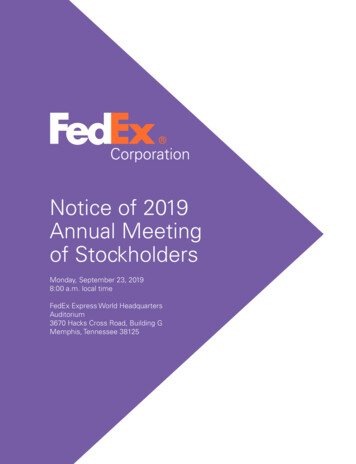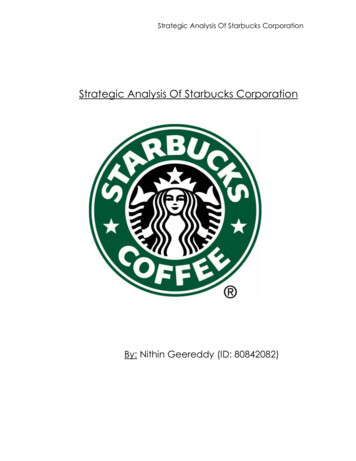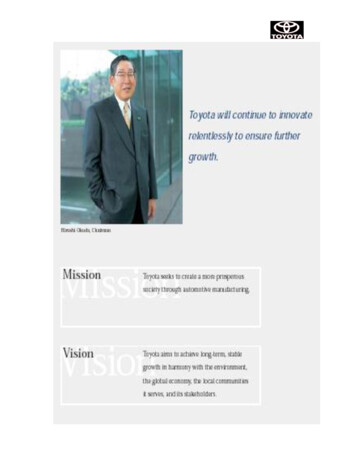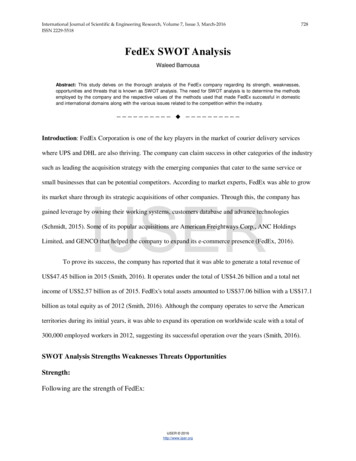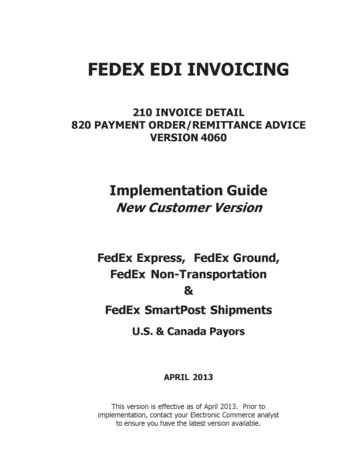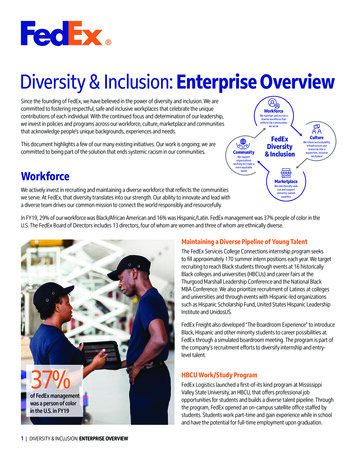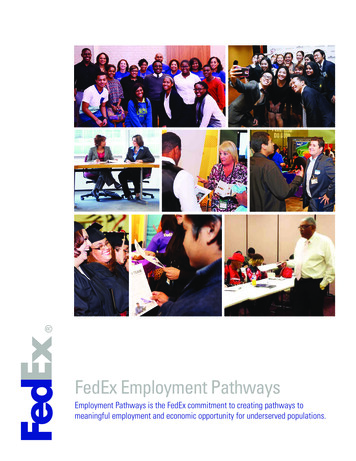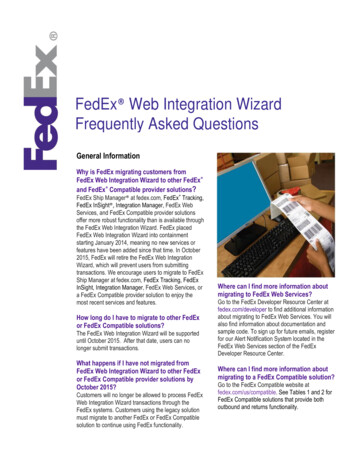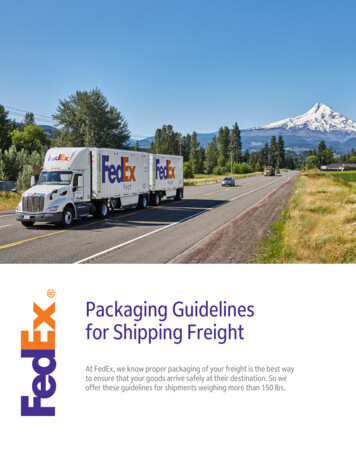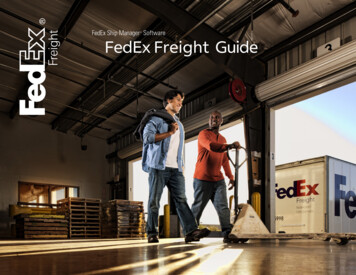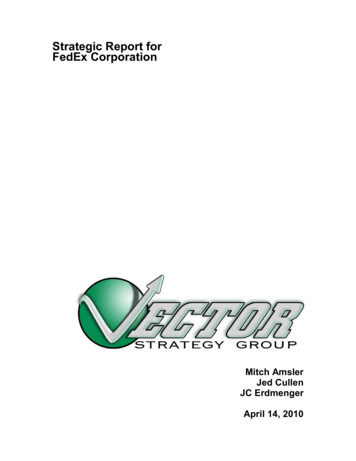
Transcription
Strategic Report forFedEx CorporationMitch AmslerJed CullenJC ErdmengerApril 14, 2010
FedEx CorporationTable of ContentsExecutive Summary . 3Company Overview . 4History . 4Business Model . 7Competitive Analysis . 10Internal Rivalry . 10Supplier Power . 11Buyer Power. 12Threat of New Entrants . 12Substitutes and Complements . 13SWOT . 14Strenghts . 14Weaknesses. 14Opportunities . 14Threats . 15Financial Analysis . 15Overview . 15Solvency and Liquidity . 16Profitability and Growth . 17Stock Price Analysis . 20Strategic Recommendations . 21References . 26Appendix . 27April 14, 20102
FedEx CorporationExecutive SummaryFedEx is a global shipping and solutions corporation that provides services toconsumers and businesses worldwide. Headquartered in Memphis, Tennessee,FedEx Corporation is the parent company that provides strategic and logisticalsupport for a variety of operating divisions, currently known as FedEx Express,FedEx Ground, FedEx Freight, and FedEx Services. These various entitiescompete collectively and are managed cooperatively under the FedEx brandname but operate relatively independently from one another. The company iscurrently the global leader in the express delivery market and offers delivery toand from individuals and businesses in over 220 countries. In 2009, FedEx wasnamed to Fortune Magazine’s 100 Best Companies to Work For and 10 MostAdmired Companies.FedEx was unable to escape damage during the economic slowdown and saw itsrevenues fall slightly and net income plummet in the 2009 fiscal year. Thecompany is subject to high fixed costs due to the nature of the business whichmade the drop in package volume across all of its divisions in 2009 especiallyhard to swallow. FedEx, however, cut costs in a strategic fashion, streamlinedoperations, and continued to invest in both its brand and its customers. As aresult, the company is poised to emerge strongly from the recession. Afterissuing impairment charges of over 2 billion in 2008 and 2009 (mostly relatedto the 2004 acquisition of Kinko’s) that ate severely into its net income, FedExhas posted strong profit results for the first three quarters of FY10. Due to thehighly competitive environment in which FedEx operates, the company facesconstant pressure to innovate, satisfy consumers, and gain market share. As thecompany looks to achieve growth in both revenue and profits in the future, it isour recommendation that FedEx focus on additional expansion into internationalmarkets, further differentiating itself from UPS, and cementing the superiority ofthe FedEx brand in the eye of consumers. This can be done through successfulimplementation of our strategic recommendations listed below.April 14, 20103
FedEx CorporationCompany OverviewHistoryThe company, conceived as Federal Express, is the brainchild of Frederick W.Smith. While Smith was an undergraduate student at Yale, he wrote aneconomics term paper about the prospects of overnight delivery service in thecomputer age; a paper for which he reportedly received a “C”. FedexCorporation’s roots trace back to 1970 when Fred Smith purchased a controllingstake in Arkansas Aviation Sales, which focused on selling and trading both newand used airplanes. He recognized that the entities currently involved in thebusiness of shipping packages and airfreight still used inefficient route deliverysystems and so he continued to develop his idea for a reliable and more efficientovernight delivery service. Smith came up with the name Federal Express for hisnew business and incorporated the new company in 1971.Federal Express operated 14 small planes and offered service to 25 U.S. citieswhen it officially began operations on April 17, 1973 with the delivery of 186packages. Smith moved the company headquarters from Little Rock, Arkansas toMemphis, Tennessee shortly thereafter due to its weather and geographic relatedadvantages. The company experienced trying times over the course of its first fewyears but did finally show its first profit in July of 1975. By this time, thecompany was delivering an average of 19,000 packages per day.Fedex benefitted greatly with the passage of the Airline Deregulation Act of 1977which removed restrictions on routes used by cargo aircraft and allowed for thecompany to add Boeing 727s and other much larger airplanes to its fleet. Thecompany went public and issued shares on the NYSE in 1978. Over the next twoyears, Fedex implemented a couple of different centralized computer systems tomanage packages, weather, vehicles, airplanes, and people in real time. By 1980,Fedex had expanded delivery to 90 U.S. cities and added Canada to its roster in1981. It was now delivering over 65,000 parcels daily. In 1983, the companyreported over 1 billion in revenues. That year, the company introducedZapMail, a satellite-based fax service that guaranteed the delivery of up to fivepages in less than two hours for just 35. However, the traditional fax machinewas just beginning to gain broader acceptance and ZapMail went on to become ahuge failure for the company, costing it hundreds of millions of dollars over theApril 14, 20104
FedEx Corporationcourse of just a few years. In 1984, the firm made its first acquisition, packagecourier Gelco Express. Other acquisitions soon followed, including businesses inEurope and the Middle East. International expansion continued in 1985 whenFederal Express established a European headquarters in Brussels, Belgium. Salesgrew to 2 billion.Acquisitions in 1987 included Cansica and Island Courier Companies. The firmadded to its international holdings in 1988, with the purchase of Italy's SAMIMAand three freight carriers based in Japan. Earnings grew to 188 million as salesneared the 4 billion mark. Federal Express also launched a new unit, calledBusiness Logistics Services, which offered transportation and operationsmanagement to other businesses.In its largest purchase to date, Federal Express paid roughly 885 million forTiger International Inc. in 1989. Tiger operated an air cargo delivery serviceknown as the Flying Tigers, which held runway rights in major metropolitanairports across 21 countries in Asia, Europe, and South America. The purchaseallowed the firm to strengthen its airfreight services, particularly overseas, wheresales nearly doubled. However, it also brought with it government safetyregulation issues and additional debt. When the deal was completed, FederalExpress was forced to contend with a debt load of more than 2 billion.By the start of the 1990s, Federal Express held 43 percent of the expresstransportation market, compared to the 26-percent market share of its largestrival, UPS. The firm effectively brought a price war to its close when it upped itsrates for the first time in seven years. The following year, the company launchedinternational cargo service EXPRESSfreighter and a new subsidiary known asFedEx Aeronautics Corp. In May of 1992, Federal Express shuttered its domesticoperations in Italy, Germany, France, and the United Kingdom, focusing insteadon shipping freight to and from Europe, rather than from one destination toanother within the continent. By the end of the year, sales had grown to 7.6billion. Express packages delivered daily averaged 1.4 million in 1993.In 1994, Federal Express changed its name to FedEx finding that customers usedthe term as a verb, meaning, "to send an overnight shipment." That same year,the company also launched www.fedex.com.April 14, 2010To compete with the same-day5
FedEx Corporationdelivery and early morning delivery services offered by UPS, FedEx beganoffering similar services for both packages and letters in 1995. The firm alsobegan making deliveries to eight countries located in the former USSR. Targetingthe rapidly growing small business and home office markets, FedEx convincedOfficeMax to let it place self-service drop boxes at OfficeMax stores nationwide.The firm also became the only U.S. cargo carrier allowed to fly in China with itsacquisition of Evergreen International Airlines. The firm's fleet had grown to 590airplanes and 38,500 vehicles. In 1997 FedEx opened its hub at Fort WorthAirport and in 1999 opened a European hub at Charles de Gaulle InternationalAirport in France.FedEx benefitted in the form of 850,000 additional packages per day when UPSemployees went on strike in 1997. The company created FDX Corp. with theacquisition of ground carrier Caliber System Inc. in 1998. Subsidiaries alsoincluded in the deal were Roadway Package Systems (RPS), Roberts Express, andViking Freight. This move allowed FedEx to begin competing properly with UPSfor market share in the domestic ground delivery market.In January 2000, FedEx unleashed the power of its global brand. In a move tofurther integrate the company's portfolio of services, FDX Corp. was renamedFedEx Corporation. In addition, Federal Express became FedEx Express, RPSbecame FedEx Ground, Roberts Express became FedEx Custom Critical, VikingFreight became FedEx Freight, and Caliber Logistics and Caliber Technologywere combined to make up FedEx Global Logistics. To centralize the sales,marketing, customer service and information technology support for FedExExpress and FedEx Ground, a new subsidiary named FedEx Corporate Serviceswas formed and began operations in June 2000. Over the next few years, anumber of acquisitions and realignments further changed the size and scope ofvarious FedEx operating companies. FedEx Corp. soon acquired TowerGroupand World Tariff Ltd. and later rebranded them as FedEx Trade NetworksTransport & Brokerage, Inc.In 2001, FedEx Express signed a 7-year contract to transport Express Mail andPriority Mail for the United States Postal Service. This contract allowed FedEx toplace drop boxes at every USPS post office, and has recently been extended untilSeptember 2013. USPS continues to be the largest customer of FedEx Express.April 14, 20106
FedEx CorporationFedEx Corp. acquired Kinko's Inc. in February 2004 for 2.4 billion in cash tobetter compete with UPS after their acquisition of Mailboxes Etc. in 2001. Twomonths later, Kinko's was rebranded as FedEx Kinko's (and later as FedEx Officein 2008). For FedEx, the acquisition meant expanded retail access to all of the1,200 FedEx Kinko's stores in operation at that time, enhanced FedEx documentmanagement services and a broader reach to customers of all sizes. In September2004, FedEx Corp. acquired Parcel Direct, a leading parcel consolidator, andlater rebranded it FedEx SmartPost. This acquisition served to complement thecompany’s contract with USPS and provides customers in the e-retail and catalogsegments with a proven, cost-effective solution for low-weight, less time-sensitiveresidential shipments.The financial crisis of 2007–2010 hit FedEx Corporation and especially itsrevenue leading Express division hard. Many companies looking for ways to savemoney stopped shipping altogether or moved to cheaper alternatives, such asground, freight and sea shipping. FedEx Corporation announced large networkcapacity reductions at FedEx Express, including retiring some of its oldest andmost inefficient aircraft such as the McDonnell Douglas DC-10 and the AirbusA310. FedEx also announced layoffs and work hour reductions at some of itshubs. Additionally, the company implemented temporary freezes in pay, andeliminated retirement fund matching contributions, and bonuses for employees.Business ModelFedEx is a global shipping and solutions corporation that provides services toconsumers and businesses worldwide. Headquartered in Memphis, Tennessee,FedEx is led by FedEx Corporation, which “provides strategic direction andconsolidated financial reporting for the operating companies that competecollectively under the FedEx name worldwide: FedEx Express, FedEx Ground,FedEx F
FedEx is a global shipping and solutions corporation that provides services to consumers and businesses worldwide. Headquartered in Memphis, Tennessee, FedEx Corporation is the parent company that provides strategic and logistical support for a variety of operating divisions, currently known File Size: 509KBPage Count: 29

